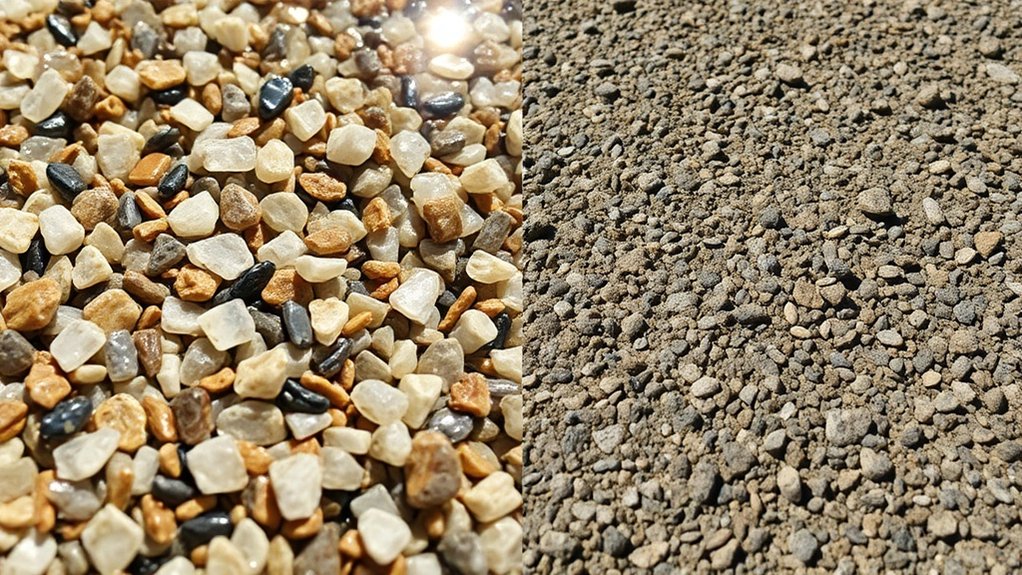Understanding the adhesion process in resin-bound versus resin-bonded systems reveals important differences. In resin-bound systems, aggregates are fully encased in resin, resulting in strong mechanical and chemical bonds that can last over 25 years. For instance, a well-installed resin-bound driveway can withstand heavy traffic without issues. On the other hand, resin-bonded systems only partially expose the aggregates, which can lead to dislodgement over time, especially in high-traffic areas.
Factors such as the type of resin used, how well the surface is prepared, and environmental conditions also play a significant role in the performance and durability of these systems. By examining these elements, we can better understand what makes for an effective and long-lasting application.
Key Takeaways
- Resin-bound systems completely encase aggregates in resin, forming robust mechanical and chemical bonds that enhance durability and longevity.
- The strength of adhesion depends on the type of resin used; epoxy provides excellent adhesion, while polyurethane is superior for impact resistance.
- Proper surface preparation, including thorough cleaning and moisture control, is essential for achieving strong adhesion in both resin-bound and resin-bonded systems.
- Environmental factors, such as temperature fluctuations and UV exposure, can adversely affect adhesion performance over time.
- Resin-bound surfaces require less frequent maintenance and offer improved drainage, whereas resin-bonded surfaces necessitate regular upkeep to maintain their integrity.
Differences in Adhesion Mechanisms
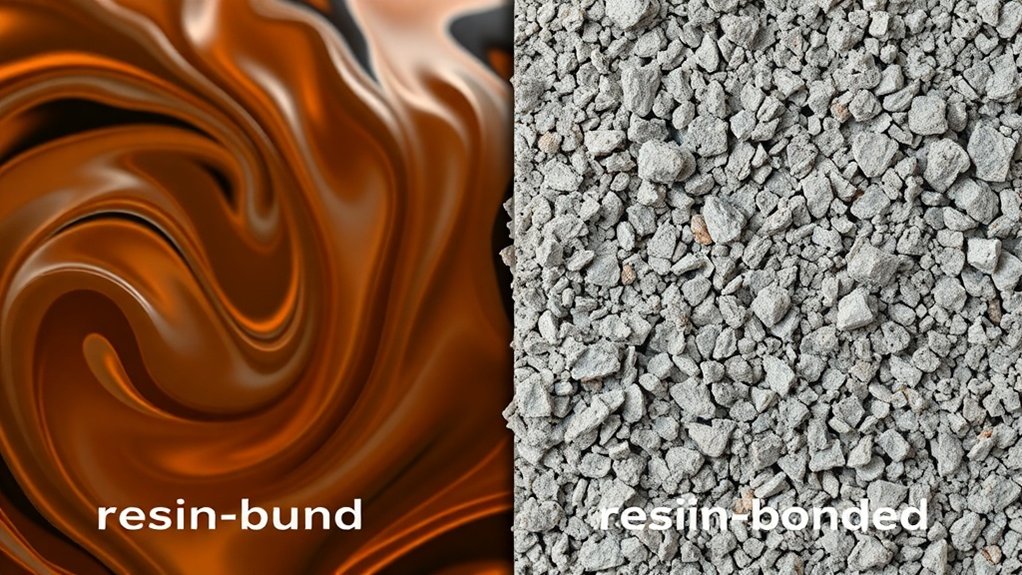
When comparing the adhesion mechanisms of resin-bound and resin-bonded systems, you’ll find key differences that affect their performance and lifespan.
Resin-bound systems achieve strong adhesion by fully encasing aggregate particles in the resin, creating both mechanical and chemical bonds with the base. This results in greater durability and resistance to environmental factors, allowing resin-bound surfaces to last over 25 years. Additionally, resin-bound surfaces are self-draining and permeable, which further enhances their resilience to water damage. As an added benefit, resin-bound systems offer superior drainage that helps prevent water accumulation.
On the other hand, resin-bonded systems depend on surface bonding, with aggregates remaining partially exposed. This can lead to dislodgement over time.
As a result, resin-bound surfaces tend to maintain their structural integrity and require less maintenance, while resin-bonded surfaces may degrade due to weaker adhesion.
Understanding these differences is crucial for choosing the right system for your application and environmental conditions.
The Role of Resin Types in Adhesion
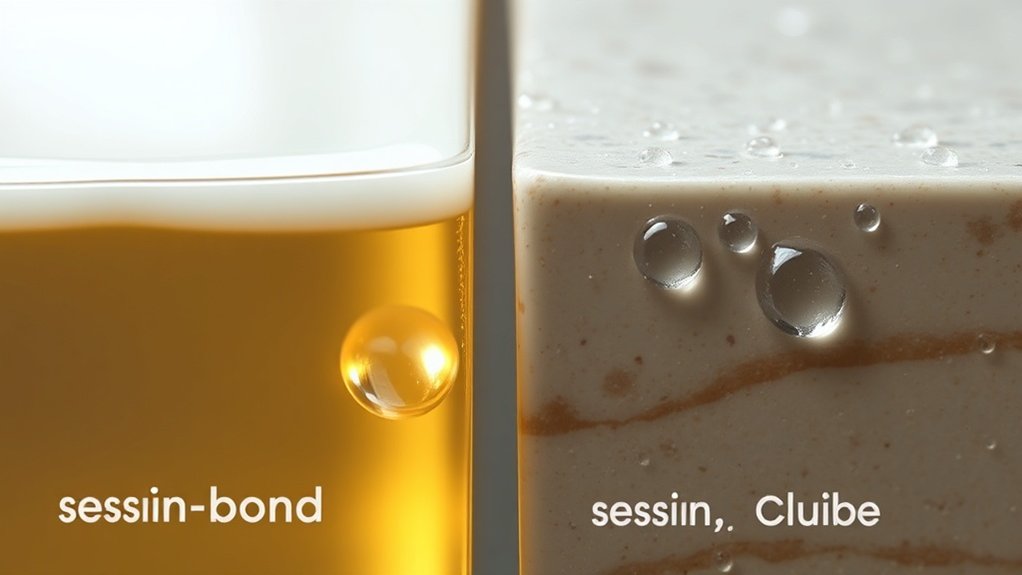
Here is the revised content with the addition of a new sentence:
—
Understanding the role of resin types in adhesion is crucial for achieving optimal performance in various applications. Your choice of resin significantly affects adhesive performance, impacting bond strength and longevity.
Here are the key types to consider:
- Epoxy resin: Offers excellent adhesion with minimal surface preparation required.
- Polyurethane resin: Provides outstanding impact and chemical resistance, making it ideal for challenging environments. Additionally, resin-bound surfaces utilize flexible resins that withstand high temperatures, enhancing their durability in extreme conditions.
- Polyester resin: More economical but often needs surface treatments for better bonding.
- Phenolic resin: Delivers strong adhesion and heat resistance, perfect for high-temperature settings.
- UV resin: Cures quickly but may not be the best option for structural bonding.
Choosing the right resin type is essential for ensuring a durable, effective bond, especially since epoxy resin can provide superior bond strength compared to others.
—
Feel free to let me know if you need any further modifications!
Impact of Surface Preparation on Adhesion
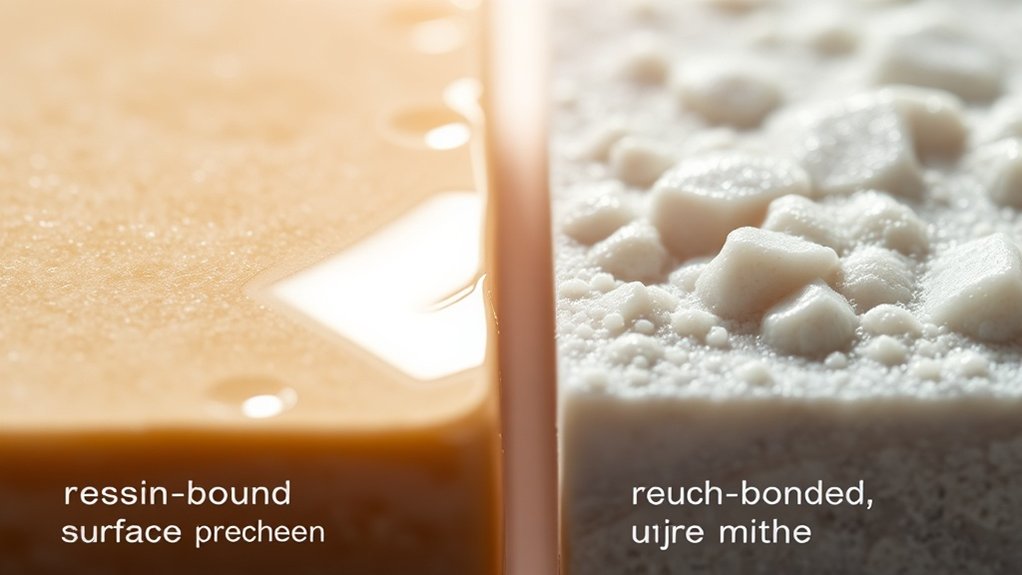
Effective surface preparation is crucial for achieving strong adhesion in resin applications, as contaminants and surface conditions can significantly affect bond strength. Thoroughly clean the surface to remove dirt, grease, and any other contaminants that could obstruct resin bonding. For resin-bound systems, a clean substrate ensures an even distribution of the resin-aggregate mix. In resin-bonded applications, both cleaning and priming enhance the bond. It’s also essential to control moisture levels; excess moisture can weaken adhesion and disrupt curing. Using techniques like pressure washing or mechanical abrasion can improve surface roughness, promoting better mechanical keying. A properly prepared surface, combined with checking moisture levels, helps prevent bond failure. Always ensure the surface is dry and well-prepared; otherwise, you risk poor adhesion, which can lead to surface failure. Proper surface preparation, along with effective moisture control, is vital for optimal resin performance, especially since resin-bound systems are fully permeable.
Factors Influencing Long-term Adhesion Performance
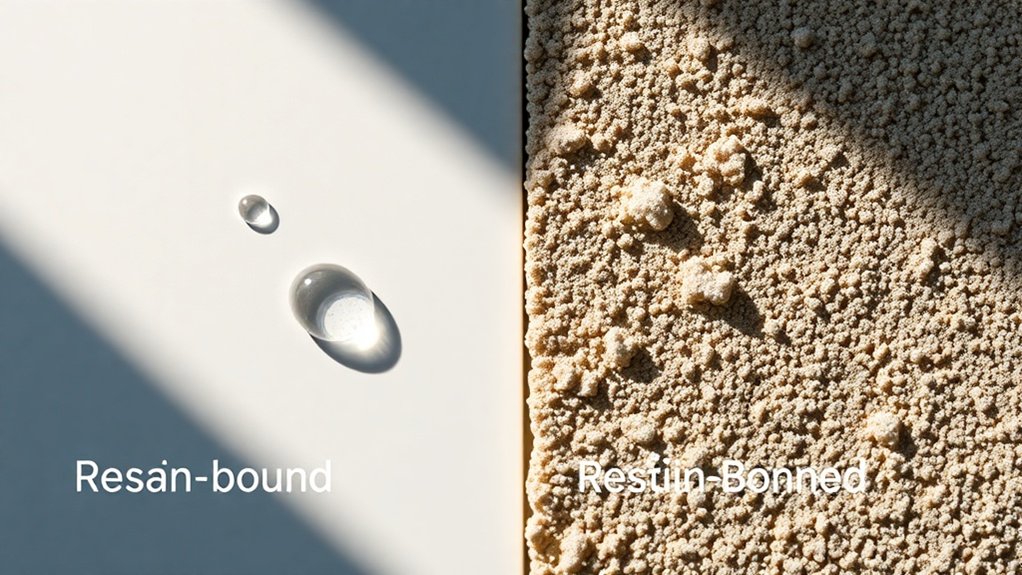
Several factors influence long-term adhesion performance in resin applications, with material selection being crucial. Here are the key considerations:
- Resin Type: Different types of resin have varying effects on adhesion strength; resin bound systems generally provide better performance than resin bonded systems.
- Aggregate Size and Type: The choice of aggregate not only influences adhesion but also affects drainage; larger aggregates can compromise the integrity of the bond.
- Resin to Aggregate Ratio: An incorrect ratio can weaken the adhesive bond, which can be assessed through adhesion testing.
- Environmental Conditions: Changes in temperature and exposure to UV light can diminish adhesion over time.
- Surface Treatments: Proper surface treatments can significantly enhance adhesion, especially in areas with heavy foot traffic.
Maintenance Implications for Adhesion Integrity
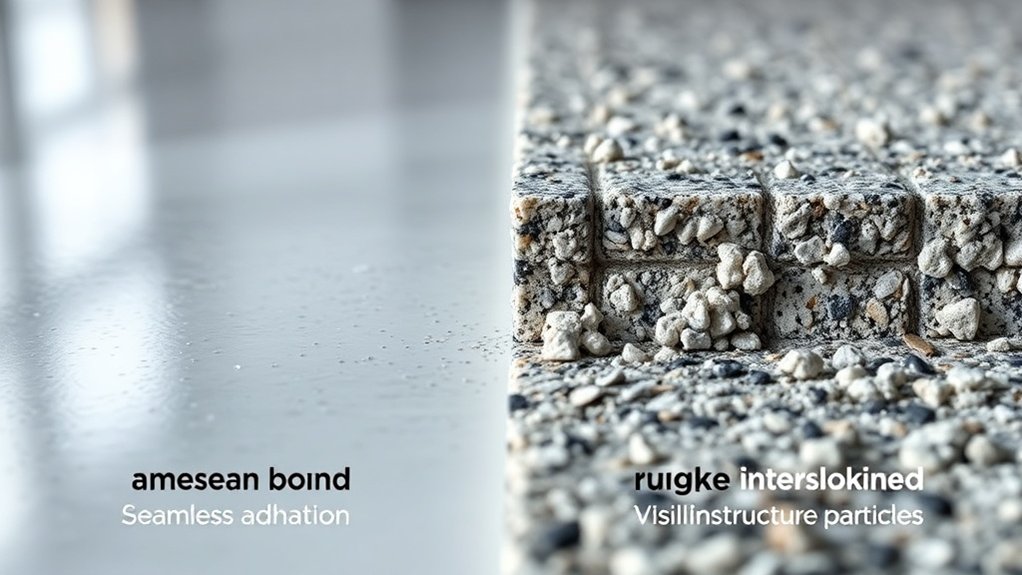
Proper maintenance is crucial for maintaining the long-term integrity of adhesion in resin applications. Knowing the differences between resin-bound and resin-bonded surfaces can help you implement effective maintenance strategies. Here’s a concise comparison:
| Surface Type | Maintenance Needs | Cleaning Techniques |
|---|---|---|
| Resin-Bound | Less frequent, easier upkeep | Basic sweeping, occasional wash |
| Resin-Bonded | Regular cleaning required | Frequent sweeping, weed removal |
| Permeability | Minimises flooding and dirt | Minimal intervention needed |
| Drainage Needs | Low maintenance | Regular inspection of drainage systems |
| Cost Consideration | Higher initial cost, lower long-term | Ongoing costs due to maintenance |
Frequently Asked Questions
What Are the Main Visual Differences Between Resin-Bound and Resin-Bonded Surfaces?
Resin-bound surfaces have a smooth, glossy finish with no loose gravel, while resin-bonded surfaces have a more textured appearance, similar to loose gravel. Both types can feature distinct colour variations, which enhance their visual appeal for various uses.
Can Resin-Bound Surfaces Be Installed Over Existing Concrete?
Yes, you can lay resin-bound surfaces over existing concrete, as long as you follow proper installation guidelines. This includes preparing the surface thoroughly, cleaning it, repairing any cracks, and ensuring the concrete is dry. These steps are crucial for achieving good adhesion and ensuring the longevity of the surface.
How Do Temperature Changes Affect Adhesion in Resin Systems?
Temperature changes significantly impact adhesion strength in resin systems. Higher temperatures can speed up curing and improve thermal stability, but they may also compromise mechanical properties. For example, using resin in warmer conditions might result in a quick set but could lead to brittleness. On the other hand, lower temperatures slow down the curing process, which can weaken adhesion strength and the reliability of the bond. For instance, applying resin in a cold environment may result in a less effective bond, making it important to consider temperature when working with these materials.
Are There Eco-Friendly Resin Options Available for Both Systems?
Yes, there are eco-friendly resin options available, such as Bostik GreenGrip. This product uses sustainable materials and contains zero VOCs. These alternatives not only enhance performance but also reduce environmental impact, making them a solid choice for those seeking responsible adhesive solutions.
What Is the Average Lifespan of Resin-Bonded Surfaces Compared to Resin-Bound?
Resin-bonded surfaces generally last between 5 to 15 years, while resin-bound surfaces can endure for 15 to 30 years. The longevity depends on the quality of materials and the installation process. Additionally, maintenance differs significantly; resin-bound surfaces require much less upkeep compared to their bonded counterparts.
Conclusion
In conclusion, recognising the key differences between resin-bound and resin-bonded adhesion is crucial for performance. By ensuring proper surface preparation, choosing the right resin, and accounting for long-term factors, you can improve adhesion strength. This careful approach not only enhances the material’s durability but also helps maintain the stability of the structure. For example, using resin-bound systems in driveways can provide better resistance to wear over time. Ultimately, a thoughtful focus on adhesion leads to reliable solutions that endure various conditions. Your attention to this process will ensure success.
